Heather Reyburn's Blog
May 11, 2024
Choko Soup (Gluten Free)
Chayote, Christophine or Choko, Mexican Pear Squash or Alligator Pear
I am quite partial to the odd choko but you don’t often see them in shops. They are an unusual looking vegetable being pear shaped, lime green, sometimes with bristles and some would say with not much flavour. Chokos originate from Southern Mexico and Guatemala, belong to the Curcurbitaceae family i.e. gourds, and have quite a few common names like Chayote, Christophine, Mirliton or just plain old Choko here in Australia/NZ. You need a bit of space to grow these, if you intend to harvest a crop yourself, as it’s quite a rampant vine. Don’t forget you will also need something for it to grow it over. Apparently all parts of this plant are edible, inclusive of roots, stems, leaves and seeds as well as the fruit itself. We prefer to use the tubers (peeled and chopped) then mixed into stir fries or seasoned and roasted in a little olive oil. And now we have this delicious soup recipe!
As is with many soup recipes there are no hard and fast measurements but rather you should taste and feel your way.
Choko soup
7 or 8 Chokos peeled and diced,
3 or 4 potatoes, again peeled and diced,
several cloves of garlic finely chopped,
1 large onion peeled and diced finely,
curry powder,
4 cups chicken stock,
1 tin of coconut milk/cream
Kaffir lime leaves (optional)
Grated or chopped fresh ginger (optional).
Splash some olive oil into a pot and sauté the garlic, ginger and onion until soft.
Add the diced choko and potatoes and continue to cook. At this point add some curry powder, (to your taste), season with salt pepper and mix through. Pour in the chicken stock and simmer until all the vegetables are tender. Add some kaffir lime leaves if you have them.
Once all is cooked through and tender, put through a blender or whizz until you have a purée and then add the tin of coconut cream and bring to simmer over a low heat so that it doesn’t stick and voilà! Choko soup.
The post Choko Soup (Gluten Free) first appeared on Heather Reyburn.
September 8, 2022
Gluten Free Peanut Brownies
An interesting piece of feedback on my latest release ‘A Stranger in Featherwood Falls’ was ‘What are Peanut Brownies’. For those of you who have read the book, you will know they feature as a family favourite in the story—so I thought, “Why not share the recipe with you all.” Those of you in the USA will refer to these types of biscuits as “cookies”. They are crunchy, filled with roasted peanuts with a chocolate flavour and are quite delicious! They also keep well in an airtight container (if they’re not eaten first) and can be sprinkled with salt flakes for extra saltiness. Here it is!
Peanut Brownies
Ingredients:
1 egg
125gms butter
1 cup sugar
1 ½ cups flour (I use Gluten free flour)
1 tsp Baking Powder
2 Dessertspoons Cocoa
1 cup peanuts (Raw or roasted)
½ teaspoon salt
½ teaspoon vanilla essence
Method:
Cream butter and sugar, add egg and beat, then all remaining ingredients.
Place small spoonful’s of mixture on a baking tray and bake for approximately 15 minutes at 180 degrees Celsius.
Allow to cool on rack before storing in an airtight container. Enjoy!
The post Gluten Free Peanut Brownies first appeared on Heather Reyburn.
Peanut Brownies
An interesting piece of feedback on my latest release ‘A Stranger in Featherwood Falls’ was ‘What are Peanut Brownies’. For those of you who have read the book, you will know they feature as a family favourite in the story—so I thought, “Why not share the recipe with you all.” Those of you in the USA will refer to these types of biscuits as “cookies”. They are crunchy, filled with roasted peanuts with a chocolate flavour and are quite delicious! They also keep well in an airtight container (if they’re not eaten first) and can be sprinkled with salt flakes for extra saltiness. Here it is!
Peanut Brownies
Ingredients:
1 egg
125gms butter
1 cup sugar
1 ½ cups flour (I use Gluten free flour)
1 tsp Baking Powder
2 Dessertspoons Cocoa
1 cup peanuts (Raw or roasted)
½ teaspoon salt
½ teaspoon vanilla essence
Method:
Cream butter and sugar, add egg and beat, then all remaining ingredients.
Place small spoonful’s of mixture on a baking tray and bake for approximately 15 minutes at 180 degrees Celsius.
The post Peanut Brownies first appeared on Heather Reyburn.
May 4, 2022
How you can help your favourite authors
All authors love feedback from readers – and there are many ways you can help our books to be seen and enjoyed. Here are just a few suggestions:
– Ask your library to purchase a copy (once an author has copies in a number of libraries across Australia, they receive a small annual fee, thanks to an initiative called the public lending rights scheme)
– Recommend the book to your friends, hairdressers, workmates and relations
– Choose it for your book group or recommend it to another book club
– Write a kind review on Good Reads/Amazon/Booktopia to help new readers find it (even a line with one reason why you liked the book is super helpful)
– Share a photo of the book on social media (don’t forget to tag the author)
– Repost an Instagram or Facebook post about the book, an event or giveaway on your social media
– Attend a book event (online or in person)
– Encourage your local book shop to stock it
– Sign up for the author’s email list
If your budget runs to buying books, please don’t be shy in pre-ordering! Contact the author directly if they are in your country (through his/her website) for a signed paperback copy. Sometimes overseas orders can be sent if a reader/buyer is prepared to pay the postage – however, unless you’re wanting a signed copy, it is usually more practical to order it through your usual sales platform.
The post How you can help your favourite authors first appeared on Heather Reyburn.
December 5, 2021
Florentine Biscuits Gluten Free
Florentines
2 cups Cornflakes (I used gluten free and crushed them a little)
½ cup sultanas
½ cup chopped glace cherries
¾ cup chopped peanuts (or you could use other nuts if an allergy is of concern)
2/3 cup of condensed milk
Mix all ingredients together and form into approximately 18 biscuits.
Place on a tray lined with baking paper and bake at 170 degrees Celsius for 10-15 minutes.
Allow to cool completely
Melt 150gms dark chocolate and either drizzle or dollop it on the top of each biscuit, or (if you’re cleverer than me), coat the base of each biscuit with the chocolate.
Refrigerate – and keep in the refrigerator until eaten.
The post Florentine Biscuits Gluten Free first appeared on Heather Reyburn.
Florentine Biscuits
Florentines
2 cups Cornflakes (I used gluten free and crushed them a little)
½ cup sultanas
½ cup chopped glace cherries
¾ cup chopped peanuts (or you could use other nuts if an allergy is of concern)
2/3 cup of condensed milk
Mix all ingredients together and form into approximately 18 biscuits.
Place on a tray lined with baking paper and bake at 170 degrees Celsius for 10-15 minutes.
Allow to cool completely
Melt 150gms dark chocolate and either drizzle or dollop it on the top of each biscuit, or (if you’re cleverer than me), coat the base of each biscuit with the chocolate.
Refrigerate – and keep in the refrigerator until eaten.
The post Florentine Biscuits first appeared on Heather Reyburn.October 25, 2021
The Challenges of Becoming an Author
Almost two and a half years ago (mid 2019), I decided the time had come to fulfil my dream of writing a book. ‘Why not?’ I hear you say. Little did I know!
I soon learned that writing is the easy part – and don’t get me wrong, I am loving it, and even more than that, I love that my readers enjoy reading my books.
What I didn’t realise before I started was that there is so much more that goes with having a book published. I can only liken the experience to an Iceberg – with the written book the part that is visible above the water-line, and everything else below, invisible to the reader – and every bit as important.
While the reader is sitting in his boat admiring the Iceberg, the author is madly paddling beneath, editing, rewriting, dreaming, thinking, researching, writing—oh and when that’s done–PUBLISHING and MARKETING.
With millions of books available online these days, having our precious work published and marketed properly is crucial. While those under forty years of age seem to have no trouble at all mastering the barrage of social media platforms available (FaceBook, Instagram, TikTok, Twitter for a start), those of us in our later years can only liken it to a five year old attempting to write a legible essay.
Suffice to say, it’s tough – and very, very rewarding!
If you enjoy reading a particular book that you have purchased (whether it’s an eBook or a physical page turner), why not consider giving the author a review?
Start with a sentence or two telling us what you liked about the book. But – don’t give away any spoilers.
Talk about what you liked about the book. Characters? The way the author writes. Did it make you laugh, or cry?
It’s also okay to talk about the things you didn’t like so much. Was it too violent? Did you hate the ending? Was a character too weak or too dominant?
Lastly – the star rating. I know a lot of authors get upset if you give them less than a 5-star rating. But here’s the thing. I don’t like every book I read so I’m pretty sure you won’t like all the books you read either. Be honest – but not cruel! Remember “It’s easier to catch a fly with honey than vinegar” – and of course, if you can’t find anything nice to say, then please move on and read a book that interests you more!
The post The Challenges of Becoming an Author first appeared on Heather Reyburn.September 22, 2021
Queensland Outback Road Trip
On the road again! After an enjoyable exploration of the disused Mary Kathleen Uranium Mine, we headed east, stopping in the delightful country towns of Cloncurry and Julia Creek. The terrain between Mt Isa and the 260 kilometres to Julia Creek continues to provoke interest with its hills and undulations covered with a variety of native fauna before the countryside morphs into wide-spread grazing properties. With a surprisingly generous cover of grasses and lots of clumps of much needed shade trees, it had its own beauty in spite of the isolation.
After stopping for a wander down the streets of Cloncurry and Julia Creek, a cup of tea and a bite to eat, we pushed on to Richmond for the night. With the town crammed with travellers, we were directed to the “overflow” camp at the local Racecourse and enjoyed beautiful, irrigated grass to sit on and watch the spectacular sunset and sunrise in this warm, dry environment. A visit to ‘Koronosaurus Korner’ in Richmond was a must with so many pieces of dinosaur skeletons to see, including the most complete skeleton of a pliosaur ever discovered. A fascinating insight to prehistoric times.
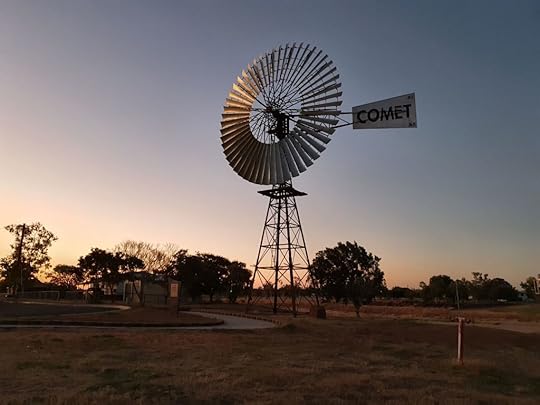 Hughenden’s Iconic Windmill
Hughenden’s Iconic Windmill Porcupine Gorge
Porcupine GorgeMoving east again to Hughenden, we set up camp and headed to Porcupine Gorge, north of Hughenden. This stunningly beautiful gorge reminded me of a miniature Grand Canyon although the steep 1.1km track descending to the valley below was significantly easier for the hiker! At the bottom, an abundance of native shrubs and trees surrounded a series of crystal clear pools, ideal for swimming. It would have been a wonderful place to dwell indefinitely, however, dusk and the steep climb back to the road had us returning reluctantly to camp.
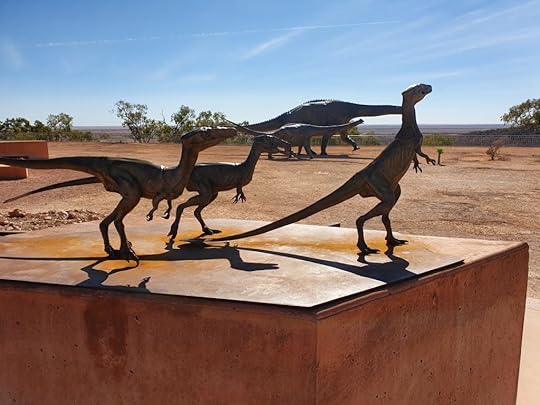

 Australian Age of Dinosaurs Museum
Australian Age of Dinosaurs MuseumThe following day we moved on to Winton where we stayed two days and could have stayed for several more! So much to see in this very pretty little town – especially as it is in the centre of the dinosaur trail. Dinner at the local pub was another experience not to be missed. Not only was the food fabulous (including several choices for Coeliacs like me), but the crowd also spilled onto the street where dozens of tables filled quickly with locals and travellers alike—reminding me very much of a busy European café. While in Winton, we spent a couple of hours enjoying the Matilda Centre and local museum, especially enjoying the history of Banjo Patterson, one of the most loved Australian poets and the author of “The Man From Snowy River”. The museum provided a fabulous window into the history and lives of the early settlers and those who followed in this harsh environment. Then (the highlight of our whole trip) a visit to the Australian Age of Dinosaurs Museum. Set on the top of a ‘jump-up’ (escarpment) overlooking the surrounding countryside with the town of Winton in the distance, this museum covers many hectares, both indoors and out. I could ramble on for hours about the incredible experience provided – but I’m sure those of you who have an interest in the Jurassic period would have already looked it up. Meanwhile I am attaching a photo or two here to give you an idea of the authenticity and hard work that has gone into constructing the facility. Before we moved on from Winton, we spent an enjoyable half hour at the ‘Musical Fence’. This ingenious invention by a local group uses pieces of scrap metal, wire, steel drums and a myriad of other bits and pieces, to provide a number of aural experiences – and is lots of fun.
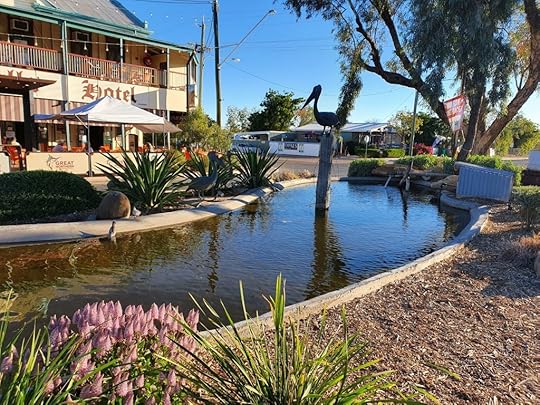 Main Street of Winton
Main Street of Winton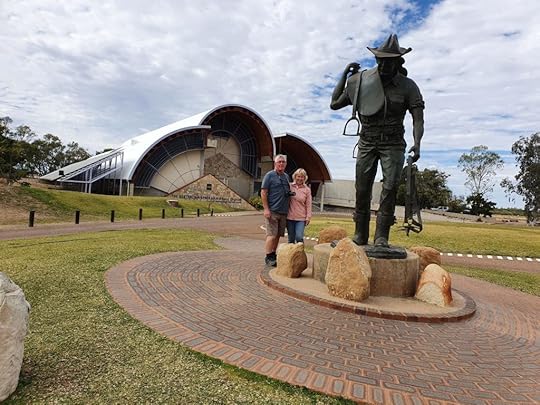 Stockman’s Hall of Fame
Stockman’s Hall of FameOn to Longreach where we enjoyed a visit to the Stockman’s Hall of Fame and a stroll down the main street. The lovely local saddler gave us a bag of old horse-shoes and my clever husband is now in the process of converting them into book stands for me! Our next stop was Ilfracombe where we had the most enjoyable and hilarious evening I have had for years. A tiny town only 27kms south of Longreach, Ilfracombe’s main street is lined with what they call ‘Machinery Mile’. For hundreds of metres, one side of the road displays every type of rural machine and vehicle that has been used for decades. It was a little (and not so little) boy’s heaven – and not exactly boring for me either! That evening, the owner of the local caravan park entertained us. A bush poet, an artist, and a genuinely delightful person, she had the forty or so campers rolling in their seats with tears streaming down faces as she reeled off poem after poem and too many jokes to count. Another unforgettable little town filled with incredible characters.
Further down the road between Ilfracombe and Isisford, we stopped to explore the ‘Stone pitching’, believed to be a legacy of the early Chinese gardeners who left the Gold Mines for independence and a better life. Thousands upon thousands of stones have been placed on their ends in waves and set into the soil. It is understood that a creek flowed through the area and the stone pitching was to slow and direct the flow over a vast area, thereby watering the acres of vegetables grown.
Another lengthy stop in Blackall was spent exploring yet another museum filled with historical – and more modern equipment, tools, and buildings – all such a wonderful example of the way the local settlers lived. Blackall sits above the centre of Australia’s vast inland water table, providing an unlimited supply of underground water. As it could be pumped out at exactly the required rate and temperature (53 degrees Celsius), the town was selected for a Wool Scour (a facility for washing the wool from the vast numbers of sheep farmed in the area). Although no longer in use due to the decline in sheep numbers, it is well maintained and a wonderful example of ingenuity.
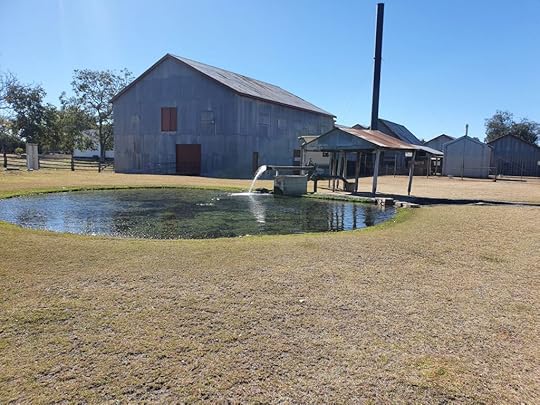 Blackall’s Wool Scour
Blackall’s Wool Scour Neil Turner Weir, Mitchell
Neil Turner Weir, MitchellOur next camping stop was Tambo – a tiny town 866kms west of Brisbane. During the ongoing drought of a decade or more, wool prices crashed dramatically in the early 1990’s and the community of Tambo were challenged to find a way of sustaining the economy of the town. Three local women banded together and planned, designed, and made the first Teddies using the hides and wool from their own merino sheep. From there, the Tambo Teddy was born – now taking pride of place in homes around the world and making Tambo the ‘Outback Teddy capital of Australia.’ Not to be outdone, the local publican also colours the towns evenings with his Chook Races. As a number of different coloured chickens chase a food cart around a track, bets are taken from the spectators on the prospective winner. Half of the money raised goes to the winner while the other half supports the Royal Flying Doctor Service of Australia – a worthy and much appreciated service in the outback.
Homeward bound, our last night was spent on the banks of the Neil Mansell Weir at Mitchell. This pretty and peaceful area with its body of water a haven for birds, was just what the doctor ordered to complete our enjoyable holiday before returning to the “real world”.
Always wonderful to get away but equally nice to be home again.
The post Queensland Outback Road Trip first appeared on Heather Reyburn.August 29, 2021
Outback Road Trip Part Two
How fortunate are we to live in such an amazing country? In this blog, I share part two of our recent Outback Queensland experiences.
After farewelling Birdsville, we travelled north, stopping to explore an area of the ancient Waddi Tree—a fairly scruffy, non-descript native tree that tested many of the early settlers. Considered one of the hardest timbers in the world, they are mostly known for the ability to not only blunt axes and chainsaws, but to be completely impenetrable, resembling steel more than wood. Rather than attempt to cut them down, farmers for generations have used them as living fence posts and allowed them to determine which direction the fence line takes.
A rocky ridge provided an interesting deviation and we clambered in and out of shallow caves, marvelling at the ability and strength of both plants and animals that live in this harsh environment.
Another forty kilometres on, we stopped again to visit the ruins of Carcory Homestead. Built in 1877 from local limestone by Hector and Norman Wilson, it was then purchased by Sir Sidney Kidman, one of Australia’s most prominent cattlemen. However, due to the harsh climate and the loss of 4000 bullocks, he also considered the area unsuitable for sustainable pastoral development and abandoned the property in 1906. Sadly, all that now remains is the shell of a small stone cottage. It is believed that the roofing iron was commandeered by the Federal Government during World War 11 and the ruin of the homestead epitomises the desolation of the place.
Further north, we reached Cuttaburra Crossing – a low lying area next to a beautiful bird filled lagoon. We set up camp in a pocket of bush beside the water and stayed for two days, walking, bird watching and enjoying reading and writing. Many water birds including several types of Cormorants, Spoonbills, Grebes, Caspian Terns, and Pelicans kept us entertained, particularly the fascinating manner in which the Pelicans work as a team to catch fish—something akin to a water ballet as they circle together and dive, heads down and tails up, in perfect unison. In the air, many different types of Kites called and swooped up and down the water and we were privy to a nest of Whistling Kite directly above us, complete with chicks.
Pushing north through ever changing countryside, we reached Bedourie—a neat little town with yet another iconic hotel made from mudbricks and daub. After refuelling and feeding handfuls of grass to Priscilla, the pet camel, we continued on to Boulia where we stayed in a gorgeous grassy campground next to the river. While the resident free ranging pony visited each caravan to check out the supply of carrots, we relished the shady trees and the jovial, friendly park operator who made our stay so enjoyable. Although very small, with only one store, an Information Centre, a service station and a few houses, Boulia is not only the western gateway to the road leading to Alice Springs (via many kilometres of rough gravelled road) but is also well known for the “Min-Min light” – a mysterious glowing orb that moves across the plains. From unknown origins, the mystical light, always in the distance, has fascinated (and terrified) many a traveller as well as the locals.
Continuing north toward Mt Isa, we were astounded at the steep, rocky hills in all directions. Somehow, my expectation of north west Queensland didn’t include desert-style mountains—and they were beautiful. Eagles and Kites were prolific, possibly encouraged by the amount of road-kill, and they swirled above us for kilometres, dropping to the road on regular occasions to eat carrion. After days of not seeing a single kangaroo or wallaby, we encountered hundreds in this area and I must admit, I was relieved as it indicated an abundance of food and water for the animals which we had been hard pressed to find.
Arriving at Mt Isa was yet another revelation. Surrounded by steep, craggy hills, the heat hit us and I wondered how anyone could have survived the summers before air-conditioning was invented. On the 20th July (mid-winter) the temperature reached 32 degrees Celsius, and the nights were certainly not cold! We could have spent several days there, visiting the many attractions as an underground mine tour, an exploration of the museum and a delicious dinner in the town managed to fill an entire day. The underground hospital (used during the wars and popular because of the cool temperatures) was another fascinating icon and the view from the lookout capturing the entire town and area, was not to be missed either.
East of Mt Isa, we explored the old uranium mine of Mary Kathleen. Memories of having studied the various mining activities of Australia at school, including this particular mine, have remained with me and I was quite disappointed to discover the road was so neglected that a good four wheel drive vehicle was essential. However, in spite of being abandoned in 1981, the layout of the original town is fascinating – and a great place to camp overnight if you are self-sufficient.
Next month, join me for the journey east via Cloncurry, Julia Creek, Richmond, and Hughenden before we turn south and explore the dinosaur trail!
The post Outback Road Trip Part Two first appeared on Heather Reyburn.July 31, 2021
Outback Road Trip in Queensland
On 12 July 2021 we set off on the first leg of our road trip to Outback Queensland – destination Birdsville.
One of the iconic and farthest western towns in the state and known throughout the country for its isolation, history and gruelling climate, Birdsville has never been more popular for visitors than now. The small but enthusiastic population of around 150 residents swells to over 10,000 during the towns two most famous annual events: The Big Red Bash (an open air music concert held in early July), and the Birdsville Races (which take place over the first weekend of September).
Getting there is not quite the challenge it has been in the past 200 odd years, however, it still entails a rough, gravel section of over 200kms that is frequently impassable after rain – and has the ability to test every piece of equipment you drive, tow and carry.
So – back to the beginning! From Toowoomba we travelled the first 440kms west, stopping at the park next to Dogwood Creek in Miles for lunch. As we pushed on toward the town of Mitchell, traffic became less frantic and while the number of cars subsided, road trains and caravans increased and eventually, even we wearied of waving excitedly to every caravan/camping combination we met. It was late afternoon by the time we set up camp beside the Neil Turner Weir, brought out the camp chairs, drinks (in my case a nice big glass of juice – but for my husband and camping friends, the liquid was a little stronger!) and cranked up the barbeque.
Day two began frosty but clear and calm and the beginnings of that “holiday feeling” started to sink in. We continued west for another 360kms or so before pulling into a working sheep and cattle property on the outskirts of Quilpie, known as “The Lakes”. As you probably know, Australia’s interior is incredibly dry – except for those irregular periods of torrential rain that bring with them, floods of minor to major proportions. Consequently, any swathe of water, be it a lake, river, billabong, or puddle, is revered. The Lake itself is a beautiful bird filled habitat – a portion of the Bulloo River and the owners of the property have taken advantage of its position and accessibility and set up a wonderful, sprawling camping area that fills every possible need. A welcoming evening campfire, bar and amenities encouraged us to join with the other forty or more campers for a couple of hours “happy hour” – and once again, those stresses and anxieties that fill our everyday lives, drifted a little further away.
Westward again, we travelled on to Windorah, a tiny town on the edge of what is known as “The Channel Country”. Several rivers drift through this part of Queensland, spreading across thousands of hectares of land after rain, leaving behind a massive network of high protein grasses that our predecessors discovered were perfect for cattle. The town is filled with so much talent, and wherever you go, you will see a variety of artwork – statues, mosaics, and paintings that showcase the colours, people and flora and fauna of the country. We took the opportunity to stay in a powered site this night, charged the batteries and filled the water tanks, ready for whatever came next.
Blue sky, gentle breezes and wide open spaces filled our day as we trundled further west. As the single strips of bitumen widened into gravel well-travelled highways, a trail of dust was left in our wake and ensured the pace was slowed to avoid our teeth rattling loose! About 130kms along the road, we made a small detour to Deon’s Lookout taking in the expanse of countryside in all directions. The vastness of this land is astounding – and at times difficult to comprehend! Next stop was the Betoota Hotel a few kilometres further on. This old pub was built in the days when the passing trade was the occasional stage-coach, camel train, or explorer. Abandoned around forty years ago and falling into rack and ruin, an enthusiastic young man looking for a challenge, purchased the building and began to renovate. Built originally from mud brick and hand hewn logs, this was no mean feat – and only a couple of years later, the pub is open again for business! Judging by the number of visitors we encountered as we sat munching our pies and enjoying a cold drink, it has been a successful project and one that, we, at least, very much appreciated. Onwards towards Birdsville – bouncing along the corrugated road but (thankfully) not encountering any boggy areas that presented problems – we finally reached the town – sitting between the Sturt Stony Desert and the Simpson Desert on the edge of the Diamantina River. After setting up camp, we explored the area, chatted to it’s many other visitors and a few residents, and, after a welcome shower, settled in the historic old pub for a delicious hot meal.
The following morning greeted us with gale force winds, blowing dust across the town so thickly it was difficult to see far in front of us. We were glad we hadn’t planned to travel on that day! We managed to purchase the few items required for minor repairs, enjoyed a Camel pie from the gorgeously rustic bakery and prepared our evening picnic before travelling out to “Big Red”. This is the highest sand dune in the area, approximately 30kms west of the town and well known for providing the visitor with spectacular views of the setting sun over the desert. Thankfully the wind had dropped by late afternoon and, perched on the topmost peak, we gazed in awe as the sun gradually sank over the western horizon and the full moon rose behind us. Wow! It was a sight I will never forget.
The post Outback Road Trip in Queensland first appeared on Heather Reyburn.


